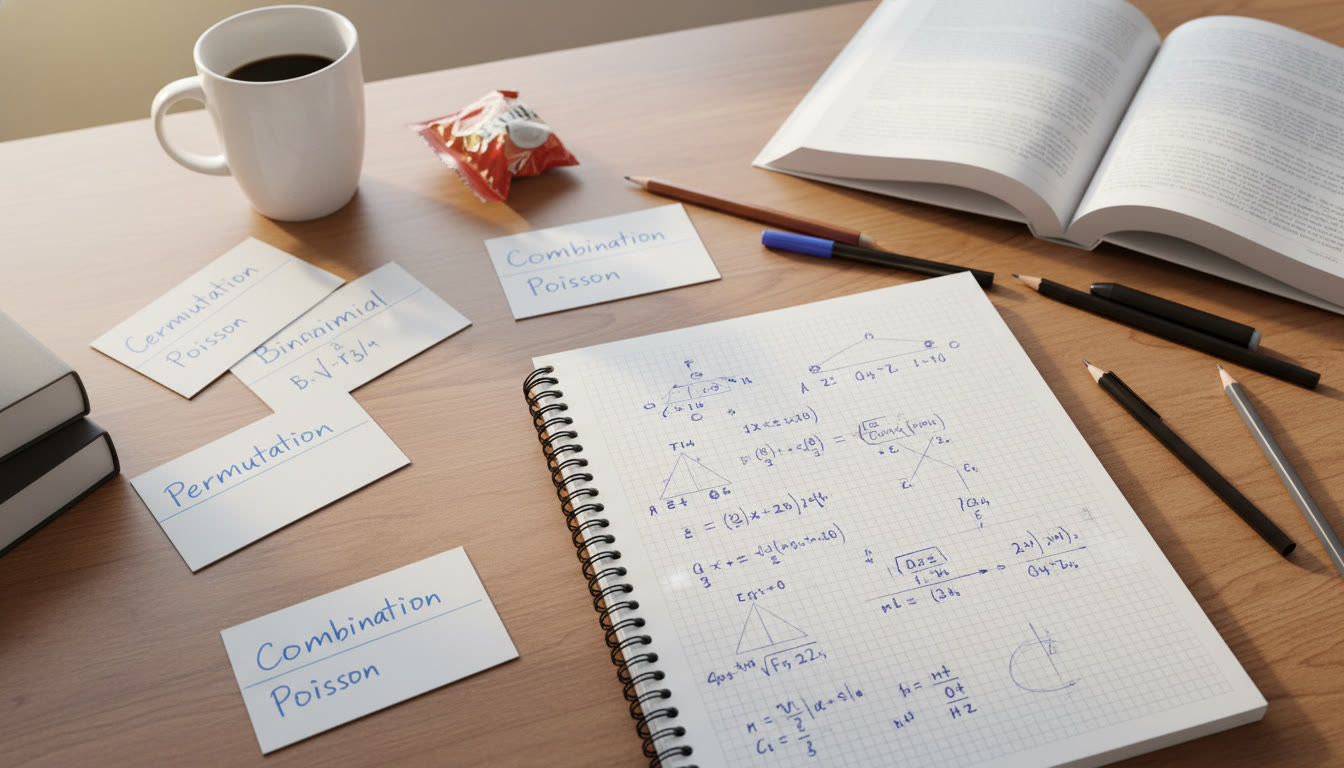Why a Mixed Hard Set is the Perfect Stretch for AP Students
Welcome — if you’re reading this, you probably like a challenge (or you’re bravely facing the one that your teacher assigned). Mixed hard sets — problems that combine probability, combinatorics, and distributions — are the kind of questions that separate the “I kind of know” students from the “I can think on the fly” students. They test not only facts and formulas but also the capacity to connect ideas: counting methods that set up probabilities, distributions that approximate combinatorial outcomes, and clever conditioning that simplifies apparent chaos.

How to Read a Mixed Hard Problem — A Quick Mental Checklist
Before you do anything else, pause and sketch a one-line plan. The most common mistakes come from jumping into arithmetic without understanding structure. Use this checklist:
- Identify whether the problem is fundamentally counting or probabilistic. Often both—counting sets the denominator/numerator.
- Look for independence or mutual exclusivity; these clues tell you whether to multiply or add probabilities.
- Decide if an exact distribution (Binomial, Hypergeometric, Poisson) models the situation — or if approximation is intended.
- Consider conditioning on an event or partitioning the sample space to simplify.
- Estimate sanity checks: probabilities must be between 0 and 1; counts must be integers; extreme cases (0 or total possible) often reveal structure.
Combinatorics Foundations You’ll Use Without Thinking (Eventually)
Permutations vs Combinations
Permutation: order matters. Combination: order doesn’t. A quick mnemonic: “Permutations = Position” — because order positions matter. For AP-level problems, this distinction influences whether you use nPr = n!/(n − r)! or nCr = n!/(r!(n − r)!).
Complement and Inclusion–Exclusion
Often “at least one” problems are easiest solved by complement: P(at least one) = 1 − P(none). Inclusion–exclusion arises when overlapping categories are present: add single categories, subtract pairwise intersections, add triple intersections, and so on.
Partitioning and Stars-and-Bars
Distributing indistinguishable objects into distinguishable boxes (or integer solutions) is classic stars-and-bars. It appears when combinatorics connects to distributions, e.g., counting ways to split trials among outcomes.
Probability: The Toolkit
Basic Properties
Remember these as instincts: the probability of a union of disjoint events is the sum of their probabilities; for independent events, multiply their probabilities; conditioning updates your sample space.
Conditional Probability and Bayes’ Flavor
Many mixed problems hinge on conditional thinking: given that A happened, what’s the probability of B? Bayes’ Theorem itself isn’t always required in full algebraic form, but the concept — reversing conditions — is a frequent trick to unlock a path.
Distributions You’ll Meet in AP Problems
Binomial Distribution
Use when you have a fixed number of independent trials, each with the same success probability p, and you care about the number of successes. Formula: P(X = k) = C(n, k) p^k (1 − p)^(n − k). You’ll see this in classic coin-flip style setups or multiple-choice guesses.
Hypergeometric Distribution
Use when sampling without replacement from a finite population. Hypergeometric often appears where combinatorics is natural — say, drawing colored balls from an urn. It relates to combinations directly, typically written with combinatorial expressions rather than a multiplicative binomial form.
Poisson as an Approximation
Poisson approximates binomial when n is large and p is small and np is moderate. AP problems sometimes hint at this approximation when modeling rare events over many trials; check the wording and numbers before applying it.
Strategy: Combine, Don’t Conquer
Hard mixed problems reward a hybrid approach. Here are specific tactics:
- Set up counts first. Express probabilities as ratios of counts when possible; combinatorics gives clean denominators.
- Use conditionals to reduce dimensions: instead of counting across a sprawling sample space, condition on a subevent with a smaller space.
- When distributions appear, translate your combinatorial counts into distribution parameters (n, p, successes, population size) — this bridges counting and probability elegantly.
- Always do a quick approximation check: if an exact fraction looks messy, estimate to ensure your final probability is sensible.
Worked Examples — Step-by-Step (Exam Style)
Example 1: Cards and Conditioning
Problem — From a standard deck, you draw three cards without replacement. What is the probability that you get exactly two hearts?
Thought process — This is sampling without replacement: classic hypergeometric. Count favorable ways and divide by total ways.
- Total ways to choose 3 cards: C(52, 3).
- Favorable: choose 2 hearts from 13 hearts and 1 non-heart from 39 non-hearts: C(13, 2) * C(39, 1).
- Probability = [C(13, 2) * C(39, 1)] / C(52, 3).
Sanity check — If you swapped to replacement (independent trials), you’d use binomial; without replacement, hypergeometric is the clean, exact method.
Example 2: Mixed Counting with Distributions
Problem — You have 5 distinct books to put on a shelf. Two of them are part of a series and must be adjacent. In how many ways can you arrange the books?
Thought process — This is permutation with a grouping trick. Treat the two-series books as a single block (but account for their internal order).
- Treat block + remaining 3 books = 4 objects to permute → 4! ways.
- Within the block, the two books can swap → 2! ways.
- Total arrangements = 4! × 2! = 48.
Application — If a probability problem asked “If one random arrangement is chosen, what’s the probability the two series books are adjacent?”, you’d divide 48 by total permutations 5! = 120, yielding 2/5 = 0.4.
Example 3: Conditioned Binomial
Problem — In a group of 7, each person independently passes a quiz with probability 0.6. Given that at least one person passed, what is the probability exactly 3 passed?
Thought process — This is conditional probability with a binomial numerator.
- P(X = 3) = C(7, 3) (0.6)^3 (0.4)^4.
- P(at least one) = 1 − P(X = 0) = 1 − (0.4)^7.
- Conditional probability = P(X = 3) / [1 − (0.4)^7].
Note — Writing conditional probabilities like this often simplifies exam calculations because common factors cancel when possible.
A Compact Comparison Table: When to Use What
| Situation | Best Model | Key Formula or Count | Common AP Pitfall |
|---|---|---|---|
| Fixed trials, independent, same p | Binomial | P(X=k)=C(n,k)p^k(1−p)^{n−k} | Forgetting independence or identical p |
| Sampling without replacement | Hypergeometric | Count using combinations (favorable/total) | Using binomial incorrectly |
| Large n, small p, rare events | Poisson Approximation | P(X=k)=e^{−λ}λ^k/k! with λ≈np | Applying approximation when np is not small/moderate |
| Order matters | Permutation | nPr = n!/(n−r)! | Using combinations instead |
Common Traps and How to Avoid Them
Trap: Overcounting
Many errors come from counting the same outcome multiple times. Use structured partitions: either split the problem into mutually exclusive cases (and add) or group indistinguishable objects first. If the result seems larger than the intuitive maximum, re-examine overlapping counts.
Trap: Swapping Independence and Identical Distribution
Just because trials look similar doesn’t make them independent. Replacement vs non-replacement is the litmus test. When independence fails, binomial formulas no longer apply.
Trap: Misapplied Approximations
Poisson and normal approximations are powerful but conditional. AP problems may ask you to state an approximation explicitly; if they don’t, prefer the exact combinatorial expression unless it’s unwieldy and the prompt suggests approximation.
Practice Mini-Set — Try These (with Hints)
Solve these without peeking at solutions. Hints are provided to nudge you in the right direction.
-
From 10 lightbulbs, 3 are defective. If you pick 4 at random, what’s the probability exactly 1 is defective? (Hint: hypergeometric ratios of combinations.)
-
You roll three fair dice. What’s the probability the maximum face value is exactly 5? (Hint: complement on “≤5” and subtract “≤4”.)
-
A computer server gets requests at an average rate of 0.2 per minute. What’s the probability exactly 2 arrive in a 10-minute window? (Hint: Poisson with λ = np.)
How to Practice Effectively — Not Just Do Problems
Quantity matters, but so does quality. Use these practice principles:
- Mix problem types. Solve a counting problem, then a distribution problem, then a conditional mix — this builds flexibility.
- After solving, write a one-sentence summary of the approach. If you can’t, your understanding is shallow.
- Time box practice sessions to simulate exam pressure, but also include untimed deep-work sessions for concept mastery.
- Work in pairs or explain solutions out loud — teaching is one of the fastest ways to identify gaps.
How Personalized Tutoring Can Accelerate This Learning Curve
Tackling mixed hard sets benefits massively from targeted feedback. A one-size-fits-all worksheet can’t diagnose whether mistakes come from weak combinatorics intuition, sloppy arithmetic, or misreading independence. Sparkl’s personalized tutoring offers one-on-one guidance that creates tailored study plans, highlights recurring errors, and uses AI-driven insights to track progress so your study time is efficient rather than merely long. When you have a dedicated tutor, they can help convert those one-line plans into reliable exam strategies you’ll use without thinking.
Exam-Day Habits for Mixed Problems
On the test, small habits add up to big score differences.
- Read the entire prompt carefully: underline numbers and qualifiers (“without replacement,” “at least one,” “exactly”).
- Use the first 30 seconds to sketch a quick plan — a sentence or two. This often saves minutes later on.
- If arithmetic gets messy, leave a clear expression and move on; come back later to evaluate or simplify. Partial credit matters.
- Perform quick plausibility checks (probabilities within [0,1], counts less than total). If your answer violates these, retrace steps immediately.
Final Example: A Full Mixed Problem (Walkthrough)
Problem — A bag contains 6 red, 4 blue, and 2 green marbles. You draw 4 marbles without replacement. What is the probability that you get exactly 2 red and at least 1 blue?
Step 1: Translate to counts. Total ways C(12, 4).
Step 2: Favorable outcomes require exactly 2 red, and at least 1 blue among the remaining 2 drawn marbles. Break favorables into disjoint cases:
- Case A: 2 red, 1 blue, 1 green: C(6,2) * C(4,1) * C(2,1).
- Case B: 2 red, 2 blue, 0 green: C(6,2) * C(4,2) * C(2,0).
Add them: Favorable = C(6,2)[C(4,1)C(2,1) + C(4,2)]. Probability = Favorable / C(12, 4). That’s a neat, test-friendly expression that’s both exact and compact.
Closing Advice — Curiosity Over Panic
Mixed hard sets are less an obstacle and more a gym for your mathematical thinking: the problems reward pattern recognition, structure-first thinking, and careful counting. If you stay curious, practice deliberately, and occasionally check in with an experienced tutor, the progress comes fast. Sparkl’s personalized tutoring can be a catalyst — tailored sessions focus your practice where it’ll help the most, and expert tutors can translate confusing phrasing into neat mathematical structure.

Resources and Next Steps
Start by selecting 10 mixed problems: five counting-heavy and five probability/distribution-heavy. Time three of them, and deeply review the other seven with the checklist from earlier. If you find recurring mistakes in a theme — say, conditional setups or replacement vs non-replacement — focus your next study block there. With deliberate cycles of practice and reflection, these mixed hard sets will become one of your favorite ways to level up.
Parting Thought
When a mixed problem looks intimidating, treat it like a puzzle rather than a test of worth. Break it down, name the parts, choose the right model, and compute carefully. Over time you’ll move from feeling reactive to feeling composed — and that calm makes all the difference on exam day.
Good luck — and enjoy the math. You’ve got this.
















No Comments
Leave a comment Cancel